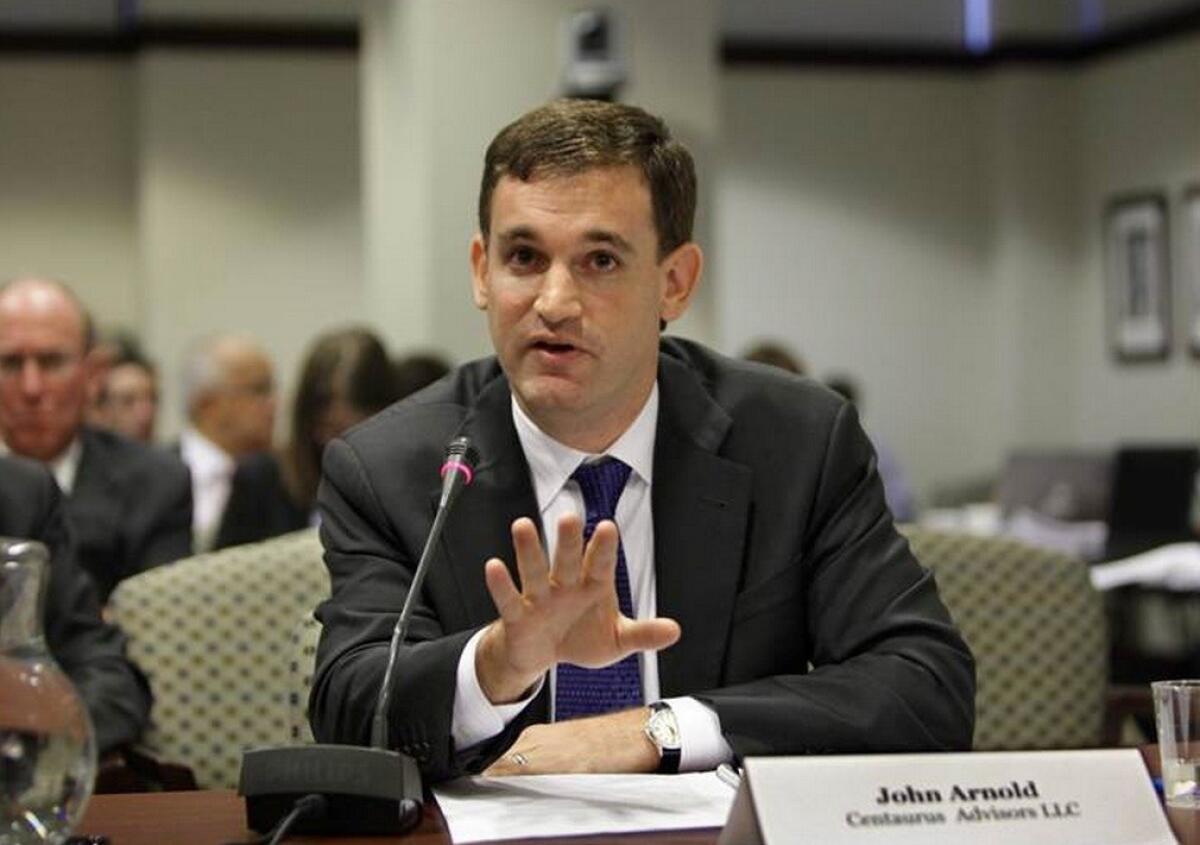Public pension shocker: Shutting a pension plan actually costs taxpayers money

What does he get out of this? Billionaire former Enron trader John D. Arnold, a backer of the campaign against public employee pensions, testifies in Washington in 2009.
- Share via
Amid the nationwide panic over the rising costs of public employee pensions, one proposed solution is nearly universal: States and municipalities should shutter their traditional defined benefit plans and place all new employees in a 401(k)-style defined contribution plan instead.
That’s the idea in a proposed California ballot initiative we reported on last week. The measure, which would end defined benefit plans for new employees as of Jan. 1, 2019, was praised by the Wall Street Journal as one that would “end defined-benefit pensions and save taxpayers billions of dollars.”
As it turns out, the Journal -- and the drafters of the initiative -- have the math exactly wrong. The experience of states that did exactly that shows that taking these steps sharply increases pension costs to taxpayers while providing employees with markedly poorer retirement benefits.
The evidence comes from a study by the National Institute on Retirement Security, whose board and advisors comprise officials of public pension agencies and leading academic experts on pension economics. The study examined the experience of West Virginia, Michigan and Alaska, each of which responded to rapidly rising unfunded liabilities in their defined benefit public pension funds by closing those plans and placing new employees in defined contribution plans.
The study found that in most cases the unfunded liabilities in the old plans rose sharply, the employees in the new plans failed to build sufficient nest eggs for comfortable retirement and the cost of pensions went up. West Virginia eventually reopened its defined benefit plan to those new employees, and they piled back in. Alaska has considered doing so, but hasn’t passed the required legislation.
The main problem with closing defined benefit plans is that the demographics within the closed plans change quickly. Without new members coming in, the number of active workers making contributions shrinks. The loss of young members making contributions for years before retirement is especially damaging. California’s giant pension fund, CalPERS, made this point in a 2011 white paper; its findings are confirmed by the experiences of the three states.
“A misperception persists ... that defined contribution plans ‘save money’ when compared with traditional pensions,” the National Institute study says. But the three states in its survey “experienced a much different reality over time.”
West Virginia, which closed its defined benefit plan for teachers to new workers in 1991, was paying benefits to 27,000 retirees by 2005, while fewer than 18,000 active teachers were still making contributions (6% of their paycheck, with the rest of the fund cost coming from the state). Meanwhile, teachers in the new plan were struggling, especially after the stock market crash of 2000-02. By 2005, the average account balance was only $41,478, and of 1,767 teachers over age 60, only 105 had balances higher than $100,000. West Virginia found that the cost of its contributions to the defined-contribution plan was roughly twice that of the traditional plan, for crummier benefits.
Michigan made a similar discovery. The state closed its traditional plan to new hires in 1997, substituting a contribution to a 401(k)-type plan of at least 4% and up to 7% of employee pay per year (depending on the worker’s own contribution). This looked like a bargain, since the state was then contributing 9.1% of pay to the defined benefit plan.
Then demographics and two market crashes took over. The aging workforce in the old plan accrued ever-rising average liabilities while the return on the plan assets fell. The plan, which had been overfunded by $734 million in 1997, showed an unfunded liability of $6.2 billion by 2012. in 1997, the state’s required annual contribution per active member was $4,140; by 2013, it was $37,100.
All three cases shared one fundamental reason for the traditional plans’ fiscal problems: The government failed to keep up with its own contribution obligations. This is endemic across the nation. It’s also the core reason for the unfunded liability in public pension plans in California, where public employers were given contribution “holidays” in the 1990s, when a bloated stock market made the public pension funds look permanently flush. When the stock market tide ran out, the wreckage emerged--and public employees, not the public officials who shortchanged the pension funds, were blamed.
The National Institute’s report is a reminder that it’s wise to ask who benefits in a shift in public employee pensions from defined-benefit to defined-contribution plans. Not the taxpayers, and not the employees. That leaves the major promoters of public-pension panic: Wall Street investment operators, such as billionaire John Arnold. Wall Street collects billions in fees from big public pension funds, but its take from millions of individual retirement accounts is potentially much higher. The lesson for taxpayers and public employees alike is clear: when you hear “experts” talking about how ending defined benefit plans will save everybody money, keep your hands on your wallets.
Keep up to date with the Economy Hub. Follow @hiltzikm on Twitter, see our Facebook page, or email [email protected].
More to Read
Inside the business of entertainment
The Wide Shot brings you news, analysis and insights on everything from streaming wars to production — and what it all means for the future.
You may occasionally receive promotional content from the Los Angeles Times.











